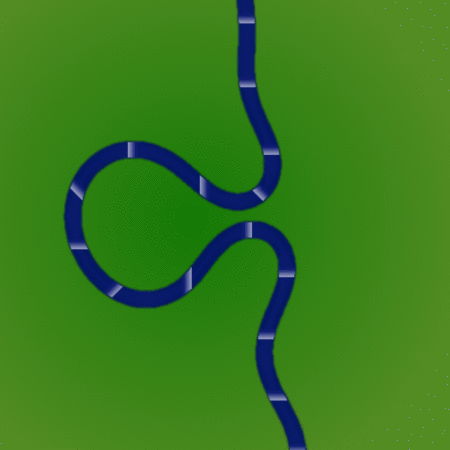|
Avulsion (river)
In sedimentary geology and fluvial geomorphology, avulsion is the rapid abandonment of a river channel and the formation of a new river channel. Avulsions occur as a result of channel slopes that are much less steep than the slope that the river could travel if it took a new course. Deltaic and net-depositional settings Avulsions are common in river deltas, where sediment deposits as the river enters the ocean and channel gradients are typically very small. This process is also known as delta switching. Deposition from the river results in the formation of an individual deltaic lobe that pushes out into the sea. An example of a deltaic lobe is the bird's-foot delta of the Mississippi River, pictured at right with its sediment plumes. As the deltaic lobe advances, the slope of the river channel becomes lower, as the river channel is longer but has the same change in elevation. As the slope of the river channel decreases, it becomes unstable for two reasons. First, water under the ... [...More Info...] [...Related Items...] OR: [Wikipedia] [Google] [Baidu] |
Mississippi Delta 1976
Mississippi () is a state in the Southeastern region of the United States, bordered to the north by Tennessee; to the east by Alabama; to the south by the Gulf of Mexico; to the southwest by Louisiana; and to the northwest by Arkansas. Mississippi's western boundary is largely defined by the Mississippi River. Mississippi is the 32nd largest and 35th-most populous of the 50 U.S. states and has the lowest per-capita income in the United States. Jackson is both the state's capital and largest city. Greater Jackson is the state's most populous metropolitan area, with a population of 591,978 in 2020. On December 10, 1817, Mississippi became the 20th state admitted to the Union. By 1860, Mississippi was the nation's top cotton-producing state and slaves accounted for 55% of the state population. Mississippi declared its secession from the Union on January 9, 1861, and was one of the seven original Confederate States, which constituted the largest slaveholding states in the natio ... [...More Info...] [...Related Items...] OR: [Wikipedia] [Google] [Baidu] |
Backwater (river)
A backwater is a part of a river in which there is little or no current. It can refer to a branch of a main river, which lies alongside it and then rejoins it, or to a body of water in a main river, backed up by the sea tide or by an obstruction such as a dam. Manmade restrictions to natural stream flow or temporary natural obstructions such as ice jams, vegetation blockage, or flooding of a lower stream can create backwater. Alternative channel If a river has developed one or more alternative courses in its evolution, one channel is usually designated the main course, and secondary channels may be termed backwaters. The main river course will usually have the fastest stream and will likely be the main navigation route; backwaters may be shallower and flow more slowly, if at all. Some backwaters are rich in mangrove forest. This results in a more diverse environment of scientific interest and worthy of preservation. Backwaters also provide opportunities for leisure activities such ... [...More Info...] [...Related Items...] OR: [Wikipedia] [Google] [Baidu] |
Sedimentology
Sedimentology encompasses the study of modern sediments such as sand, silt, and clay, and the processes that result in their formation (erosion and weathering), transport, deposition and diagenesis. Sedimentologists apply their understanding of modern processes to interpret geologic history through observations of sedimentary rocks and sedimentary structures. Sedimentary rocks cover up to 75% of the Earth's surface, record much of the Earth's history, and harbor the fossil record. Sedimentology is closely linked to stratigraphy, the study of the physical and temporal relationships between rock layers or strata. The premise that the processes affecting the earth today are the same as in the past is the basis for determining how sedimentary features in the rock record were formed. By comparing similar features today to features in the rock record—for example, by comparing modern sand dunes to dunes preserved in ancient aeolian sandstones—geologists reconstruct past environmen ... [...More Info...] [...Related Items...] OR: [Wikipedia] [Google] [Baidu] |
Geomorphology
Geomorphology (from Ancient Greek: , ', "earth"; , ', "form"; and , ', "study") is the scientific study of the origin and evolution of topographic and bathymetric features created by physical, chemical or biological processes operating at or near Earth's surface. Geomorphologists seek to understand why landscapes look the way they do, to understand landform and terrain history and dynamics and to predict changes through a combination of field observations, physical experiments and numerical modeling. Geomorphologists work within disciplines such as physical geography, geology, geodesy, engineering geology, archaeology, climatology, and geotechnical engineering. This broad base of interests contributes to many research styles and interests within the field. Overview Earth's surface is modified by a combination of surface processes that shape landscapes, and geologic processes that cause tectonic uplift and subsidence, and shape the coastal geography. Surface processes co ... [...More Info...] [...Related Items...] OR: [Wikipedia] [Google] [Baidu] |
Head Cut (stream Geomorphology)
A head cut (alternately headcut ), in stream geomorphology, is an erosional feature of some intermittent and perennial streams. Headcuts and headward erosion are hallmarks of unstable expanding drainage features such as actively eroding gullies. Headcuts are a type of knickpoint that, as the name indicates, occur at the head (upstream extent) of a channel. The knickpoint, where a head cut begins, can be as small as an overly-steep riffle zone or as a large as a waterfall. When it is not flowing, the head cut will resemble a very short cliff or bluff. A small plunge pool may be present at the base of the head cut due to the high energy of falling water. As erosion of the knickpoint and the streambed continues, the head cut will migrate upstream. Groundwater seeps and springs are sometimes found along the face, sides, or base of a head cut.North Carolina Division of Water Quality, "Identification Methods for the Origins of Intermittent and Perennial Streams, Version 3.1", Febru ... [...More Info...] [...Related Items...] OR: [Wikipedia] [Google] [Baidu] |
Meander
A meander is one of a series of regular sinuous curves in the channel of a river or other watercourse. It is produced as a watercourse erodes the sediments of an outer, concave bank ( cut bank) and deposits sediments on an inner, convex bank which is typically a point bar. The result of this coupled erosion and sedimentation is the formation of a sinuous course as the channel migrates back and forth across the axis of a floodplain. The zone within which a meandering stream periodically shifts its channel is known as a meander belt. It typically ranges from 15 to 18 times the width of the channel. Over time, meanders migrate downstream, sometimes in such a short time as to create civil engineering challenges for local municipalities attempting to maintain stable roads and bridges.Neuendorf, K.K.E., J.P. Mehl Jr., and J.A. Jackson, J.A., eds. (2005) ''Glossary of Geology'' (5th ed.). Alexandria, Virginia, American Geological Institute. 779 pp. Charlton, R., 2007. ''Fundamentals ... [...More Info...] [...Related Items...] OR: [Wikipedia] [Google] [Baidu] |
Sinuosity
Sinuosity, sinuosity index, or sinuosity coefficient of a continuously differentiable curve having at least one inflection point is the ratio of the curvilinear length (along the curve) and the Euclidean distance (straight line) between the end points of the curve. This dimensionless quantity can also be rephrased as the "actual path length" divided by the "shortest path length" of a curve. The value ranges from 1 (case of straight line) to infinity (case of a closed loop, where the shortest path length is zero or for an infinitely-long actual path). Interpretation The curve must be continuous (no jump) between the two ends. The sinuosity value is really significant when the line is continuously differentiable (no angular point). The distance between both ends can also be evaluated by a plurality of segments according to a broken line passing through the successive inflection points (sinuosity of order 2). The calculation of the sinuosity is valid in a 3-dimensional space (e. ... [...More Info...] [...Related Items...] OR: [Wikipedia] [Google] [Baidu] |
Meander Cutoff
A meander cutoff is a natural form of a cutting or cut in a river occurs when a pronounced meander (hook) in a river is breached by a flow that connects the two closest parts of the hook to form a new channel, a full loop. The steeper drop in gradient (slope) causes the river flow gradually to abandon the meander which will silt up with sediment from deposition. Cutoffs are a natural part of the evolution of a meandering river. Rivers form meanders as they flow laterally downstream, see sinuosity. Meandering rivers flow higher and hence with more total flow, pressure and erosion on the outside of their bends due to forming a vortex as in a stirred coffee cup and consequently the river erodes more the outer bank. On the inside bend of a river, the level is lower, secondary flow moves sand and gravel across the river bed creating shallows and point bars, and friction of air and perturbances of the bed act against a higher proportion of the column of water, being shorter, slowing th ... [...More Info...] [...Related Items...] OR: [Wikipedia] [Google] [Baidu] |
Massachusetts Institute Of Technology
The Massachusetts Institute of Technology (MIT) is a private land-grant research university in Cambridge, Massachusetts. Established in 1861, MIT has played a key role in the development of modern technology and science, and is one of the most prestigious and highly ranked academic institutions in the world. Founded in response to the increasing industrialization of the United States, MIT adopted a European polytechnic university model and stressed laboratory instruction in applied science and engineering. MIT is one of three private land grant universities in the United States, the others being Cornell University and Tuskegee University. The institute has an urban campus that extends more than a mile (1.6 km) alongside the Charles River, and encompasses a number of major off-campus facilities such as the MIT Lincoln Laboratory, the Bates Center, and the Haystack Observatory, as well as affiliated laboratories such as the Broad and Whitehead Institutes. , 98 ... [...More Info...] [...Related Items...] OR: [Wikipedia] [Google] [Baidu] |
New Hampshire
New Hampshire is a U.S. state, state in the New England region of the northeastern United States. It is bordered by Massachusetts to the south, Vermont to the west, Maine and the Gulf of Maine to the east, and the Canadian province of Quebec to the north. Of the 50 U.S. states, New Hampshire is the List of U.S. states and territories by area, fifth smallest by area and the List of U.S. states and territories by population, tenth least populous, with slightly more than 1.3 million residents. Concord, New Hampshire, Concord is the state capital, while Manchester, New Hampshire, Manchester is the largest city. New Hampshire's List of U.S. state mottos, motto, "Live Free or Die", reflects its role in the American Revolutionary War; its state nickname, nickname, "The Granite State", refers to its extensive granite formations and quarries. It is well known nationwide for holding New Hampshire primary, the first primary (after the Iowa caucus) in the United States presidential election ... [...More Info...] [...Related Items...] OR: [Wikipedia] [Google] [Baidu] |
Suncook River
The Suncook River is a river located in central New Hampshire in the United States. It is a tributary of the Merrimack River, which flows to the Gulf of Maine. Course The Suncook River begins at the outlet of Crystal Lake in the town of Gilmanton, New Hampshire. The village of Gilmanton Ironworks is located at the lake's outlet. The Suncook flows south two miles to the Suncook Lakes (Upper and Lower) in Barnstead. Below the lakes, the river passes through the village of Center Barnstead and enters the town of Pittsfield, whose village is centered on a 19th century dam on the river. The river continues south through the towns of Chichester and Epsom, and then forms the town boundary between Pembroke and Allenstown. Shortly before reaching the Merrimack River, the Suncook drops in , a natural waterpower site that led to the growth of the village of Suncook. 2006 flood On May 16, 2006, the Suncook River, responding to the highest rainfall amounts in at least 70 years (more ... [...More Info...] [...Related Items...] OR: [Wikipedia] [Google] [Baidu] |
Hydraulic Head
Hydraulic head or piezometric head is a specific measurement of liquid pressure above a vertical datum., 410 pages. See pp. 43–44., 650 pages. See p. 22. It is usually measured as a liquid surface elevation, expressed in units of length, at the entrance (or bottom) of a piezometer. In an aquifer, it can be calculated from the depth to water in a piezometric well (a specialized water well), and given information of the piezometer's elevation and screen depth. Hydraulic head can similarly be measured in a column of water using a standpipe piezometer by measuring the height of the water surface in the tube relative to a common datum. The hydraulic head can be used to determine a ''hydraulic gradient'' between two or more points. "Head" in fluid dynamics In fluid dynamics, ''head'' is a concept that relates the energy in an incompressible fluid to the height of an equivalent static column of that fluid. From Bernoulli's principle, the total energy at a given point in a fluid i ... [...More Info...] [...Related Items...] OR: [Wikipedia] [Google] [Baidu] |





.jpg)
